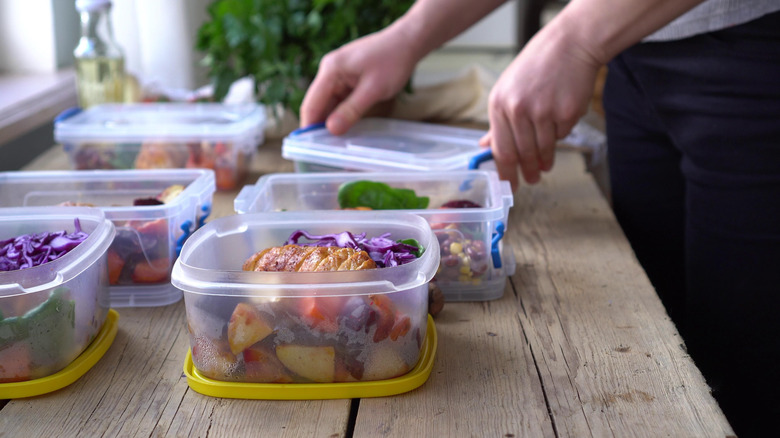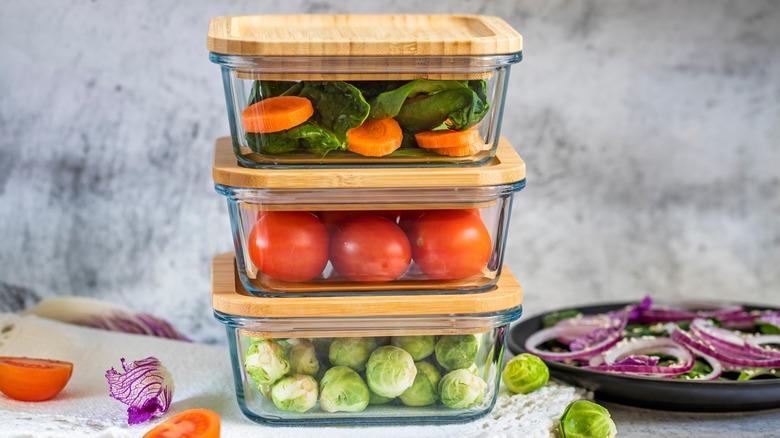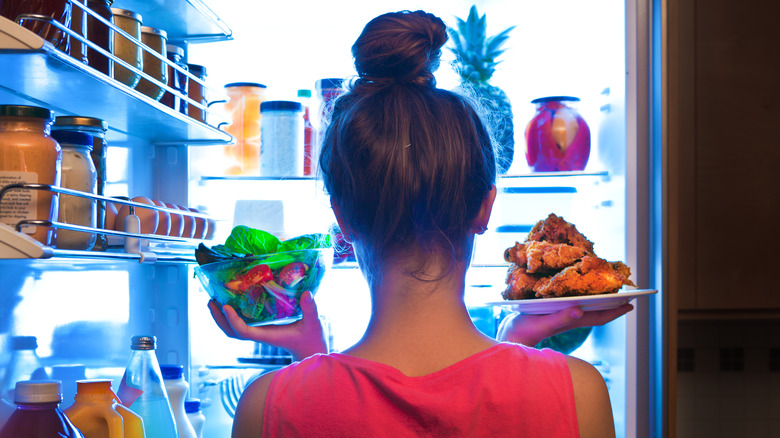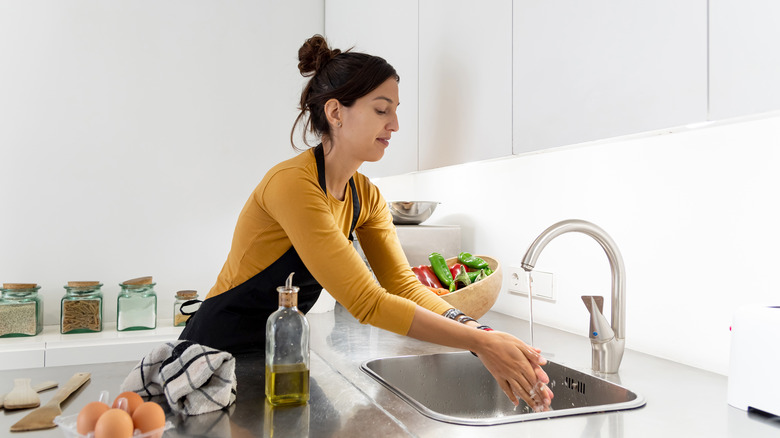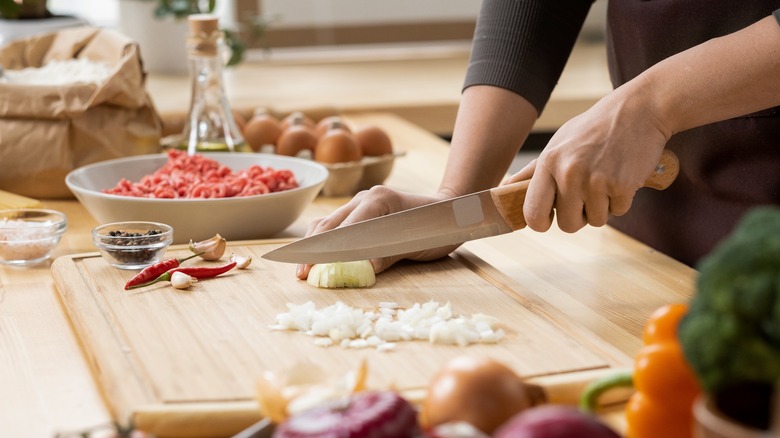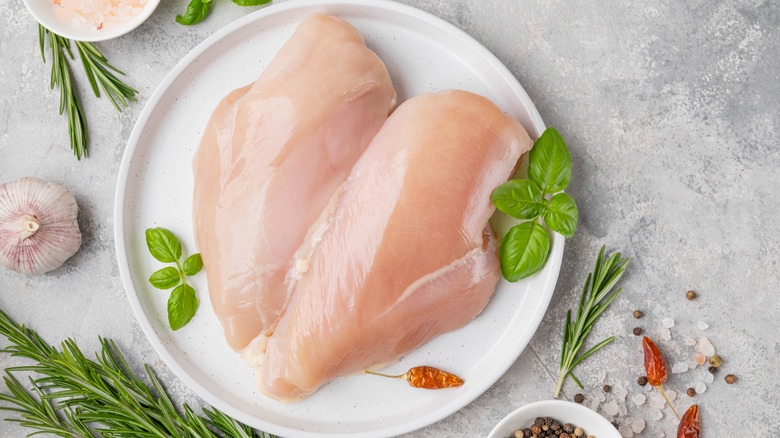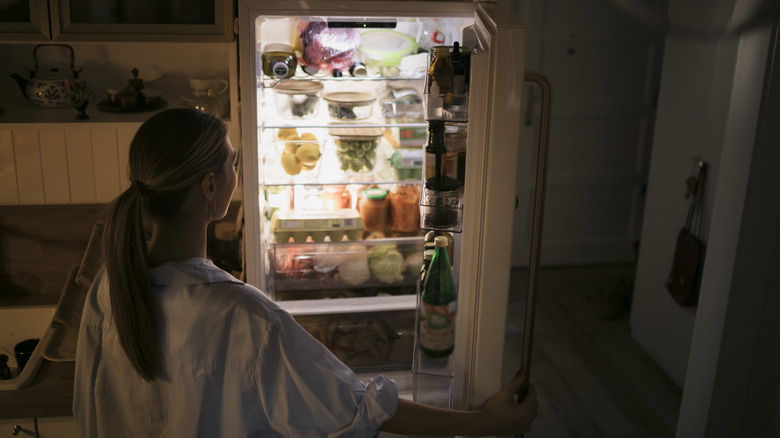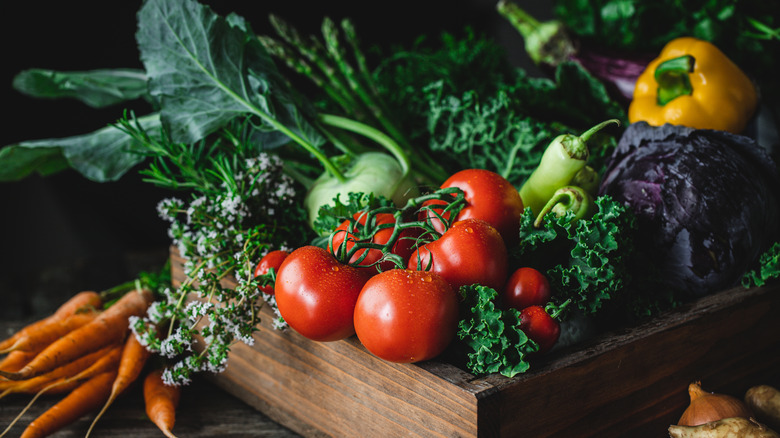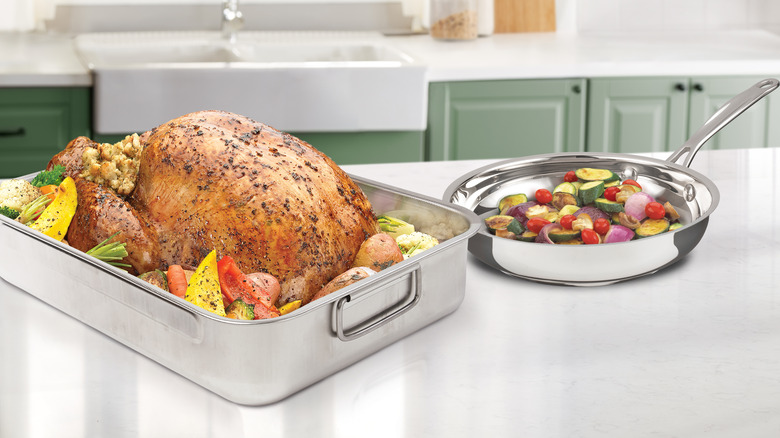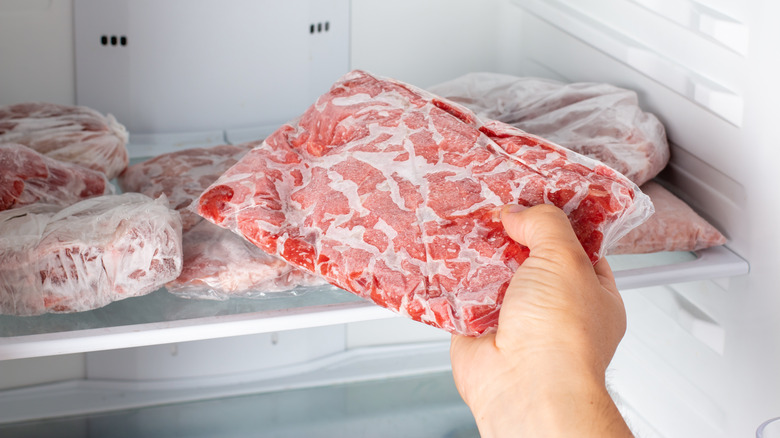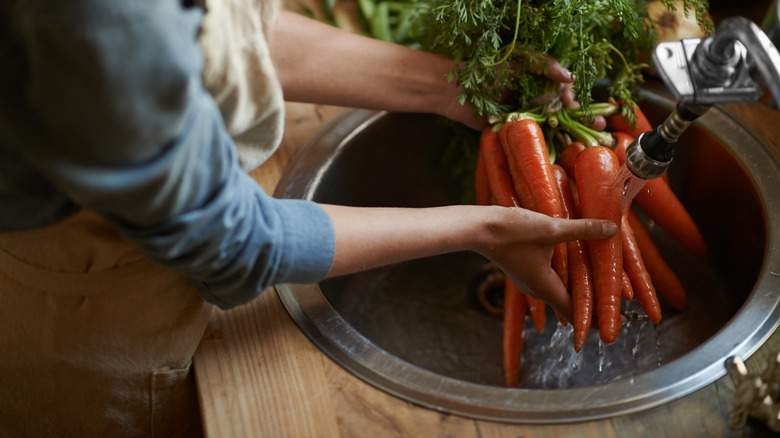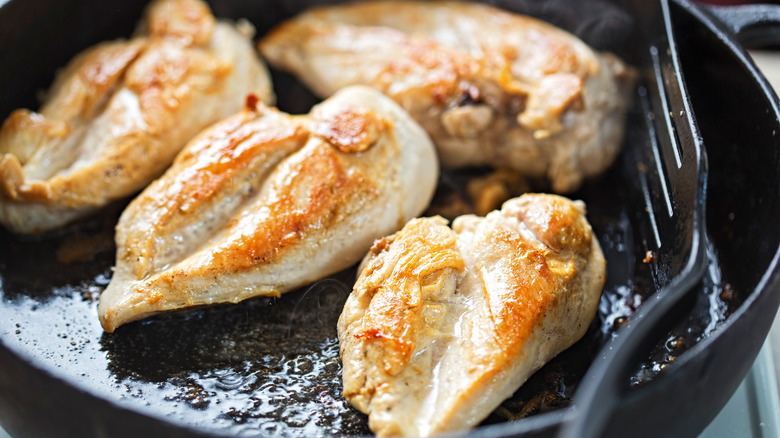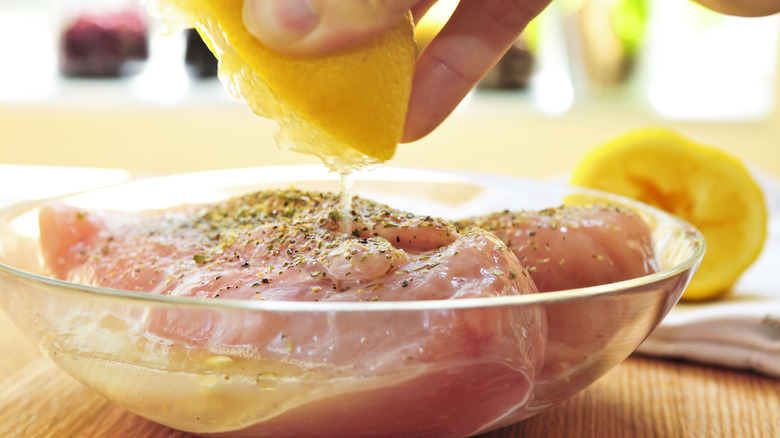Meal Prep Mistakes That Can Lead To Food Poisoning
There's nothing more welcoming than a home-cooked meal at the end of a busy day, and few things are as satisfying as the knowledge you've made that meal yourself. But if you work long hours, and have a bunch of kids to look after, finding the time or energy to make a full dinner at the end of a busy workday may not be realistic. That's why so many dedicated home cooks have embraced meal prepping — preparing whole meals or components of meals all at once, typically over the weekend, to be heated up on the fly during the work week. This is a smart move that will keep you sane and prevent a lot of last-minute rushing — whether you're prepping for the entire week or just that evening's dinner.
And since you might be making more food than you're used to when meal prepping, it's especially important that you keep food safety in mind — the last thing you want is for friends and family to come away from the table with food poisoning. Even experienced cooks can make sloppy mistakes in the kitchen, especially when trying to prep multiple dishes at once. Not to worry, you don't have to turn your kitchen into a NASA laboratory to keep your food safe to eat. All you need is to be aware of some common food-handling and meal prep errors — and know how to avoid them.
Storing food too long
Preparing dishes in advance is wise. But prepping too far in advance can increase the chance of food spoiling and becoming contaminated. Even foods stored in the freezer have a finite shelf life– and foods stored in the fridge may not last as long as you think. A cooked salmon fillet, for instance, stays safe in the fridge for only three days, meaning that poaching a side of salmon on Monday for a Friday night party is not a great idea.
If you're not sure how far in advance it's safe to prep your dishes, foodsafety.gov (a site jointly run by the Food Safety and Inspection Service, the Food and Drug Administration, and the Centers for Disease Control and Prevention) has an easy-to-read chart listing the refrigerator and freezer shelf life of common foods. Using this information, you can schedule your meal prep tasks to ensure more perishable foods are still fresh and safe when you're ready to serve them.
Storing food improperly
Once you've prepped a dish (or part of a dish) in advance, it's important to properly store it to ensure it stays fresh (and safe) until it's ready to serve or use in future cooking. This basically means keeping perishable foods cold and taking steps to keep them from becoming contaminated. For instance, be sure to cover foods before you refrigerate them. This not only helps protect them from picking up odors from other foods, but prevents molds and yeasts (which can advance even at refrigerator temperatures) from settling in. Minimizing your food's exposure to air also helps preserve its flavor.
And it's important to lessen the chance of food becoming contaminated by food residue in your fridge. So even if no one will see them but you, be mindful to wipe up spills or crumbs in your refrigerator before they get into other food. Juices from raw meat, poultry, and fish can be especially dangerous if introduced to other foods, since they can carry pathogens such as E. coli and salmonella (which are killed off during cooking). For this reason, it matters where different types of food are stored in the fridge: Raw proteins such as meat and fish should always be stored on the bottom shelf so they can't drip juices onto foods below them.
Not washing your hands between prepping tasks
It's common knowledge that you should wash your hands before cooking. But if you plan to spend several hours in the kitchen with meal prep tasks, once may not be enough. As you work, you're going to touch a range of foods and objects — from vegetables to kitchen sponges to your refrigerator door to maybe your child or even your cat (no shaming here — we know it happens). So if you want to keep your food clean and free from kitchen grunge and pet germs, you'll want to wash your hands multiple times as you work.
This means washing your hands not only before cooking, but after handling proteins such as meat, poultry, or eggs. If you wear gloves for dishwashing or other kitchen tasks, wash your hands after taking them off — this will remove any contaminants from your hands and protect any food you touch next. If you need to wipe down a counter or do any other cleanup in the middle of your prepping, wash your hands afterward to keep cleaning fluids from being transferred to food. And here's another good reminder: Wash your hands after touching garbage or pets and after sneezing, coughing, or taking a bathroom break.
Using the same utensils on raw meat and produce
Even those of us who love to cook can agree that washing dishes is a boring (and sometimes) arduous chore. Few things can sap your culinary inspiration more than the sight of a sink full of dirty dishes and utensils, all demanding your attention. This is why experienced cooks strategize their meal prep to minimize the amount of dishwashing they'll need to do. For instance, lining baking pans with foil and using measuring cups for dry ingredients before wet ones will save you a round of washing.
But while re-using measuring cups and other utensils without washing them is often a smart way to save time, water, and work, think twice if you're going to be using raw meat or poultry. While meat and poultry are perfectly safe when properly cooked, they can harbor pathogens such as salmonella and E. coli when raw — so it's critical that you keep raw meat or anything it's come into contact with away from other foods. This means thoroughly washing knives, cutting boards, or other utensils in hot, soapy water after they've been used to prepare raw meat. To be extra safe, some cooks use separate, color-coded cutting boards and even knives for meat and other foods.
Washing your meat
It seems that keeping things clean is the guiding principle underlying food safety practices. And certainly, no one can argue against common-sense measures such as keeping your kitchen (and kitchen utensils) clean and ensuring you're cooking with fresh, uncontaminated food. But counterintuitive as it sounds, not everything in your kitchen needs to be cleaned before use. For instance, take the common practice of giving poultry or meat a quick rinse before seasoning and cooking it. It sounds like it should make these foods safer, and many cooks believe it's a useful way to remove undesirable excess juices and other residue — but in reality, it raises your chance of spreading food poisoning.
This is because washing meat is an inherently messy process. Think about what happens when you put a whole chicken or roast under a kitchen faucet: You're moving it from a cutting board to the sink and back again, (perhaps using a colander or bowl), and you'll probably employ a towel or two to dry it off. And no matter how careful you are, there's a good chance meat juices will splatter onto the sink and surrounding counters. Add to that all the other surfaces and utensils that have been exposed to raw meat juices — a known source of illness-causing organisms — and you can see how washing meat increases the chances of other foods becoming contaminated.
Keeping your refrigerator at the wrong temperature
Keeping prepped foods securely covered and storing them in the fridge should keep them safe — but only if your refrigerator is doing its job. Ideally, your refrigerator should kept at 40 degrees Fahrenheit or lower, and your freezer at 0 degrees Fahrenheit or below. To ensure your refrigerator is adequately cold, invest in a thermometer you can keep in the fridge to see it's working properly.
Should you experience a power outage, you can preserve your food longer by keeping the refrigerator door closed as much as possible — this will help keep food cooler longer. If your power is out for more than four hours — and if the internal temperature of your refrigerator rises above 40 degrees Fahrenheit — use a thermometer to check the internal temperatures of perishable foods such as leftovers and meat. If it's at 45 degrees Fahrenheit or below, they're fine to eat, but do so quickly; they have a short shelf life. If they're warmer than that, toss them.
Not washing produce properly
Most of us automatically wash our produce before using it, giving fruits and veggies a quick rinse and whirling salad greens in a salad spinner after splashing water over them. For many of us, the only time we do anything more than that when cleaning our produce is if it has visible clumps of dirt on it. Indeed, we're so conditioned to thinking of fresh produce as wholesome and health-giving it's hard to imagine how anything other than massive amounts of dirt on it could get us into trouble.
And while fresh fruits and veggies are unquestionably healthful, like all foods, they can carry disease-causing contaminants, such as bacteria and pesticide residue. So your job is to give all produce a thorough rinse under running water, using your hands to free debris, then drying it off with a towel before cutting or cooking with it. Also, inspect your produce for any bruises or external damage and cut these areas away, since they can serve as entry points for contaminants. Plain water will work fine for washing, but you can also use a cleaning solution of one part vinegar or lemon juice and two parts water.
Leaving food unrefrigerated too long
Ironically, food is most susceptible to bacterial contamination at the exact temperature range we're most likely to eat it – between 40 and 140 degrees Fahrenheit. In this temperature range, known to food service professionals as the temperature danger zone, the number of bacteria on food can double in as little as 20 minutes. This obviously doesn't mean your food is going to turn deadly the moment you pull it from the oven or fridge. Leaving food out for the length of a leisurely dinner is fine — but to be safe, it's best to minimize the amount of time any food stays in this zone.
In practice, this means getting cooked, prepped food back into the refrigerator as soon as possible after it's cooked. Putting warm or hot food in the fridge is perfectly safe. But to be extra cautious, divide large portions into smaller storage containers to ensure they cool quickly. If you're bringing a cold dish to a party, be sure to use ice packs or gel packs to keep it cold.
Thawing food on the counter
If you're among the super-organized who plan and prep your meals far in advance, you probably have an arsenal of dishes in the freezer, ready to be thawed and reheated for serving. But if you've gone to all the trouble to prepare and freeze a homemade dish, an important step you can take to ensure it stays fresh and safe to eat all the way to the dinner table is to thaw it safely. And unfortunately, the go-to method for a lot of us — simply removing frozen items from the freezer and plunking them on the kitchen counter a few hours before dinner — is not a good idea and can promote food poisoning.
This is because foodborne pathogens, like people, thrive in the ambient temperatures of most kitchens and can multiply quickly on the surfaces of exposed food — even food that's still mostly frozen. Thus, if you leave food out on a counter for prolonged periods, you run a chance of having it contaminated by the time it's fully thawed. Safer options are to thaw your food covered in the refrigerator (this will take longer, so plan to start thawing further in advance) or to use your microwave, which will thaw food quickly enough to avoid potential problems.
Not washing fruits and veggies before peeling them
It's pretty obvious to most home cooks why it's important to wash salad greens or fruit to be eaten whole, such as strawberries and grapes. What's less obvious is the need to wash parts of produce that we're never going to eat, such as melon or squash rinds. Since they'll never hit our plates, what difference does it make whether or not they're clean?
Surprisingly, it does make a difference in terms of food safety. If you're cutting into a whole melon, for instance, your knife will pass through the rind and into the melon's flesh — and unless you've thoroughly washed the melon first, the knife will drag any dirt and pathogens from the melon's surface onto the edible part of the melon. This isn't just a theoretical possibility: In 2011, 30 people were killed in a listeria outbreak caused by contaminated cantaloupe pieces (via State Food Safety). Listeria bacteria thrive in soil and farm runoff, and can easily settle into the craggy rinds of cantaloupes and other melons; it's believed that the outbreak was due to such bacteria making contact with cut melon flesh. So even though you might feel silly doing it, wash that skin before you peel it off and discard it — your digestive system will thank you.
Undercooking proteins
Serious meal prepping cooks strive to create flavorful, fast-to-the-table make-ahead meals — and they attempt to do it efficiently. This means seeking out hacks for speeding up the meal prep process without compromising quality or flavor. Among the recommendations making the rounds is the advice that you slightly undercook chicken and finish the cooking when you reheat the meal before serving. Here's the thought process: You'll save prep time and be spared the misery of eating overcooked chicken.
While it's smart to slightly undercook vegetables so they won't turn soggy when you reheat them, this is not a safe move with chicken, which needs thorough cooking (to an internal temperature of 165 degrees Fahrenheit) to ensure any naturally existing pathogens are killed off. Partially cooked chicken leaves these bad guys unharmed and ready to contaminate the rest of your meal — and that's not something you want. Do yourself (and your guests) a favor by cooking chicken all the way through.
Marinating food at room temperature
Marinades and brines not only make food more tender and flavorful, but can help it last longer. Marinating and brining were first developed as methods of food preservation, and some acidic marinades used in commercial poultry processing have been found to control the growth of certain pathogens.
But while marinating food can make it safer, it doesn't make it completely germ proof. So when marinating perishable foods such as raw meat and poultry, treat them with the same care as other raw foods of the same type. Because it can take an hour or more for a marinade to fully penetrate your meat and contribute a good level of flavor, it might be tempting to save refrigerator space by leaving the meat to marinate on the kitchen counter. However, this is asking for trouble – perishable food and ambient temperatures are a bad mix, and even with a marinade, bacteria can still multiply quickly on your food. So play it safe and keep marinating meats and other foods safely in the fridge until they're ready to cook.

